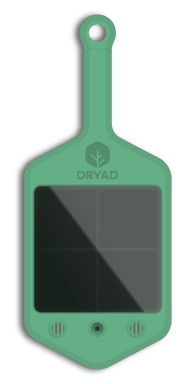
-
StatusOngoing
-
Status date2025-05-16
-
Activity Code7A.078
The aim of this research and technology development project is to develop an innovative Internet of Things (IoT) sensor that enables cost-effective and scalable direct-to-satellite communication of gas sensors for ultra-early forest fire detection.
The innovation is intended to build upon Dryad‘s existing fire gas sensors, which will be equipped with a novel satellite antenna and edge computing software and integrated into a completely new product.
Dryad‘s innovative IoT sensor, equipped with direct-to-satellite communication is expected to:
- Operate in the 400 MHz frequency range;
- Establish connections with low Earth orbit (LEO) satellites through tree canopies;
- Have a maintenance-free operational lifespan of at least ten years;
- Not require special satellite modules.
Dryad plans to develop an antenna that has a small spatial footprint, high energy efficiency, and can operate maintenance-free in the forest for at least ten years, since the sensor is attached to trees.
Power is sourced via commercially available solar cells and excess energy is stored in supercapacitors to ensure operation at night or on cloudy days.
The sensor needs to be usable in topographically challenging areas to guarantee a high coverage density.
Signal interferences and off-axis emissions from the satellite antenna, which may lead to a signal decay or interference, must be prevented.
Unlike cameras or satellite-based detection systems that can take hours to detect a wildfire due to obstructions by tree canopy, Dryad’s sensor provides real-time, under canopy fire detection, even in dense forests with pinpoint accuracy, maintenance-free operation, and market-leading cost efficiency.
Dryad’s sensors are solar-powered, detecting forest fires with embedded AI using gas sensors, measuring temperature, humidity, and air pressure. With reduced reaction time, Dryad’s newest generation of direct-to-satellite enabled wildfire sensors will help to protect the world’s largest carbon sink, addressing deforestation and emissions from forest fires.
Dryad’s sensor network is complementary to existing monitoring and alerting systems. The direct-to-satellite sensor system is a perfect addition to satellite-based monitoring systems which can provide visual analysis and monitoring of forest fires and other developments. With sensors for ultra-early detection of forest fires (sensing H2 emissions of smouldering fires), Dryad aims to significantly reduce the reaction time to minutes from ignition, enabling fire fighters to extinguish the fire before it spreads out of control.
When integrated with Kinéis’s constellation of Internet of Things (IoT) satellites, the sensors overcome terrestrial telecommunications limitations, ensuring near real-time global connectivity and enabling the early detection of wildfires even in remote areas with no network coverage.
Dryad takes advantage of recent developments in sensor technology, embedded AI/machine learning (ML), wireless technology, energy harvesting and mesh networking and combines these with proprietary enhancements to provide an open, scalable solution specifically for deploying large-scale sensor networks in the forest.
Dryad’s novel direct-to-satellite wildfire sensor employs highly sensitive gas detection sensors and volatile organic compound (VOC) sensors, with built-in AI to ensure accurate fire detection.
Using Long Range Wide Area Network (LoRaWAN) and direct-to-satellite technologies for wireless data transmission, the device is to operate maintenance-free for ten to 15 years and uses supercapacitors instead of batteries, eliminating the need for lithium and other toxic materials.
Leveraging Semtech’s advanced chipsets, which combine terrestrial LoRaWAN and Kinéis’s satellite connectivity into a single solution, this integration ensures users can deploy products with both terrestrial Low-Power Wide-Area Network (LPWAN) and satellite connectivity.
- Dimensions: 23.7 x 9.7 x 2.1 cm
- Weight: 136 g
- Solar panel size: 8.2 x 8.2 cm
- Operational temperature: -10°C to +40°C
- Operational humidity: 15% to 95%, non-condensing
- Ingress protection: IP67
- Material: plastic (weather and UV proof)
- Modulation: 400 MHz
- Signal strength: 27dBm nominal operation
The foundation for the development of this project is Dryad‘s solar-powered, edge computing-enabled fire gas sensors. These sensors measure fire-specific compound concentrations and microclimate data and communicate via LoRaWAN radio. To eliminate false alarms, such as those triggered by cigarette smoke, the sensors are equipped with machine learning systems that differentiate odours and ensure reliable forest fire detection. Each sensor can monitor approximately one hectare of forest, and has a maintenance-free operational lifespan of up to 15 years.
The sensor system contains numerous gas detection sensors and VOC sensors and a custom-built antenna that connects to terrestrial communications systems via LoRaWAN and to a low Earth Orbit (LEO) Internet-of-Things (IoT) constellation of nanosatellites by satellite operator Kinéis. Sensor installations for linear infrastructure such as powerlines or railways, or in difficult terrain such as mountainous regions and areas with limited terrestrial telecommunications network coverage will benefit from direct-to-satellite connectivity.
The Kinéis satellite system is expected to include a total of 25 nano satellites and about 20 ground stations and will achieve full operational capability (FOC) by mid 2025, enabling signal transmissions with very low latency.
- Result from Requirements Analysis (Work Package [WP] 1): Comprehensive specification document (Milestone (MS) 1);
- Research on direct-to-satellite IoT communication outdoors (WP2): will make project-relevant analysis results available (MS2);
- Research on direct-to-satellite IoT communication in the forest (WP3): will make project-relevant analysis results from tests available (MS3);
- Development of a project-specific antenna system (WP4): Result will be a provisionally operational antenna system (MS4);
- Development of a project-specific edge-computing firmware (WP5): will yield a provisionally operational edge computing firmware (MS5);
- System integration (WP6): results in an operational IoT sensor in the form of a functional prototype (Technology Readiness Level (TRL) 5) (MS6).
- After finalising the sensor requirements specification after the kick-off of the project in 2024, an antenna concept has been developed in collaboration with Finnish antenna specialist Radientum, followed by simulations and optimisations.
- In spring 2025, the assembled Printed Circuit Board (PCB) and the sensor housing design were completed. A first prototype was built and tested in one of the forests available to Dryad for testing purposes. Full Operational Capability of Kinéis’s constellation is scheduled for June 2025.
- Producing a first batch of sensors is planned, allowing for learnings from the first production run. Large-scale production is planned for 2025.




